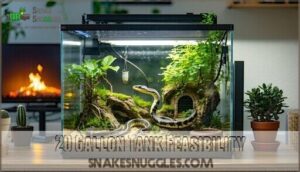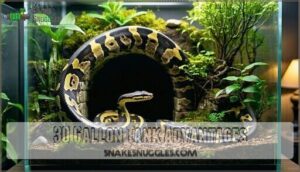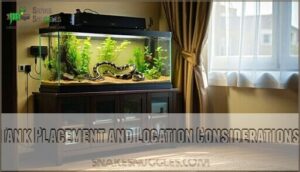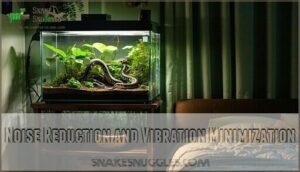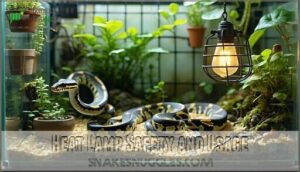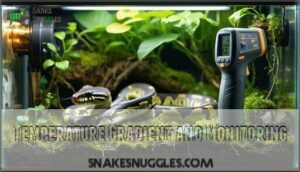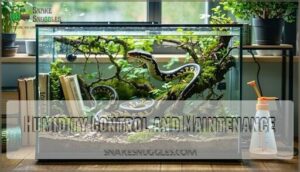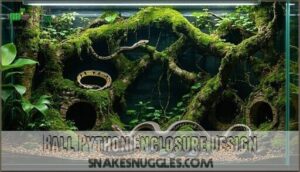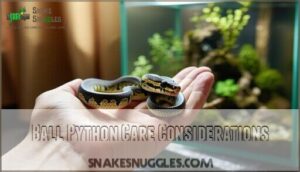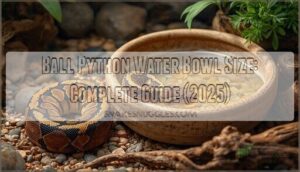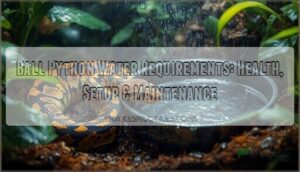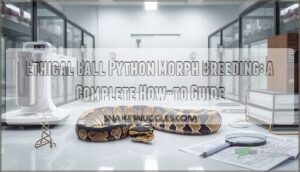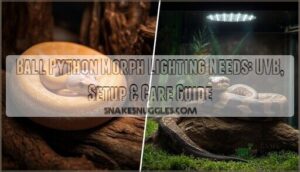This site is supported by our readers. We may earn a commission, at no cost to you, if you purchase through links.
 Setting up a ball python in a small apartment is totally doable with smart planning. You’ll need a minimum 40-gallon tank for an adult, though juveniles can start in 20-gallon setups.
Setting up a ball python in a small apartment is totally doable with smart planning. You’ll need a minimum 40-gallon tank for an adult, though juveniles can start in 20-gallon setups.
Choose a long, low tank over tall ones since ball pythons prefer ground space. Position it away from high-traffic areas to minimize stress and vibrations.
Essential equipment includes under-tank heating pads, ceramic heat emitters, and proper hides on both warm and cool sides. Maintain temperatures between 78-92°F with 50-60% humidity.
Use lightweight substrates like cypress mulch or paper towels for easy maintenance. The secret lies in maximizing vertical space and choosing equipment that doubles as décor.
Table Of Contents
- Key Takeaways
- Ball Python Space Needs
- Small Apartment Tank Options
- Ball Python Heating Requirements
- Ball Python Enclosure Design
- Ball Python Care Considerations
- Frequently Asked Questions (FAQs)
- Can you leave a heat lamp on 24/7 for ball python?
- Do ball pythons like small spaces?
- Can a ball python live in a 30 gallon tank?
- What electrical costs come with ball python heating?
- Can ball pythons escape from standard apartment tanks?
- Do ball pythons require permits in rental properties?
- How often should apartment tank water be changed?
- What apartment neighbors should know about ball pythons?
- Conclusion
Key Takeaways
- You’ll need a minimum 40-gallon tank for adult ball pythons – juveniles can start smaller, but invest in a proper size from the beginning to avoid upgrades and ensure your snake’s comfort throughout its life.
- Smart heating setup is crucial for apartment living – use under-tank heating pads with thermostats and ceramic heat emitters to maintain 78-92°F temperatures without bulky equipment that overwhelms your space.
- Strategic placement reduces stress and maximizes functionality – position your tank away from high-traffic areas and direct sunlight, using anti-vibration mats to minimize noise transfer to neighbors.
- Proper hides and humidity control create a thriving environment – provide secure hiding spots on both the warm and cool sides while maintaining 50-60% humidity through careful substrate choice and water bowl placement.
Ball Python Space Needs
Creating the perfect ball python habitat in a limited space requires careful planning of your enclosure’s dimensions and layout.
You’ll need to balance your snake’s essential requirements—proper heating zones, secure hiding spots, and adequate room to move—with the practical constraints of apartment living, considering essential requirements.
Minimum Tank Size Requirements
Your ball python needs a minimum 40-gallon terrarium as an adult, though many experts recommend starting with a 75-gallon reptile enclosure.
Your snake’s home should grow with them—invest in adequate space from day one for happier, healthier pets.
A hatchling tank can be smaller initially, but considering your snake’s growth rate and long term needs prevents ethical concerns about cramped conditions.
Adult size requirements mean investing in proper ball python habitat from the start saves money and guarantees quality ball python care throughout your pet’s life in your snake enclosure.
You can find appropriate terrarium products here to ensure the best environment for your ball python, providing a suitable space for its entire life, which is crucial for its long term needs.
Tank Shape and Layout Considerations
Once you’ve determined your Tank Dimensions, consider Vertical Space and Enrichment Layout carefully.
Your compact reptile setup requires strategic Clutter Density planning. Position hides at opposite ends, creating secure pathways between them.
This spacesaving terrarium approach maximizes your small apartment setup’s Visual Appeal while providing essential behavioral zones.
Your reptile enclosure becomes both functional and attractive through thoughtful terrarium organization.
Heating and Lighting Space Requirements
Your heating setup needs careful planning for ideal ball python temperature needs.
Consider bulb wattage between 75-100 watts for basking spots, while ceramic heat emitters provide nighttime warmth without disrupting lighting schedule.
Proper thermostat placement guarantees accurate readings and prevents overheating.
Space ventilation prevents heat pockets, and energy consumption remains manageable with efficient reptile heating options that meet reptile lighting requirements.
Hiding Places and Visual Barriers
Your ball python needs secure hides and visual security to feel safe in small apartments.
Apartment friendly snakes require multiple hides throughout their reptile terrarium to reduce stress effectively.
- Secure hides: Place one hide box on each side of the enclosure for temperature regulation
- Visual security: Add plants or decorations to minimize enclosure clutter while creating natural barriers
- Stress reduction: Low maintenance pets like ball pythons thrive with proper hiding spots in small apartment pets setups
Small Apartment Tank Options
You’ll find several tank options that work perfectly in cramped quarters without sacrificing your snake’s comfort.
While space might feel tight, choosing the right enclosure size and placement can create an ideal home for your ball python.
20 Gallon Tank Feasibility
Consider a 20-gallon tank as your temporary solution for juvenile ball pythons in small apartment pets setups.
Space limitations make this apartment friendly snakes option cost effective initially, but your python’s growth rate demands upgrades within twelve months.
While python setup works short-term, enrichment options remain limited in smaller reptile terrarium spaces, requiring creative snake bedding and decor arrangements for proper python size accommodation.
Ball pythons are popular pets because of their remarkably docile nature.
30 Gallon Tank Advantages
A thirty-gallon tank transforms your ball python setup with remarkable space efficiency and cost savings compared to larger alternatives.
This apartment-friendly reptile setup offers easier maintenance through reduced cleaning frequency while providing superior temperature stability.
The compact terrarium design remains beginner friendly, giving your snake adequate room for natural behaviors without overwhelming your living space or budget, making it a great option for cost savings.
Tank Placement and Location Considerations
Position your ball python tank away from direct sunlight exposure and high-traffic areas.
Choose a stable surface with proper weight distribution to support the filled enclosure. Make certain easy accessibility for daily maintenance while maintaining security concerns against pets or children.
Adequate floor space around the tank allows comfortable access to heating, lighting, and substrate changes. Consider proximity to electrical outlets for equipment while avoiding areas with temperature fluctuations, ensuring proper weight distribution and easy accessibility.
Noise Reduction and Vibration Minimization
Your ball python’s home needs quiet spaces for proper rest and feeding.
Place foam pads or anti-vibration mats under tanks to reduce transferred vibrations by 60%. Choose plastic or PVC enclosures over glass for better sound absorption.
Position tanks away from noisy walls, appliances, and speakers. Cork sheets beneath stands further dampen vibrations.
These apartment-friendly pet solutions create peaceful environments for small space reptile keeping, which is essential for proper rest.
Ball Python Heating Requirements
Creating the right temperature conditions for your ball python is essential for their health and comfort in your apartment setup.
You’ll need to establish proper heating zones and maintain consistent temperatures to keep your snake thriving in their compact living space, ensuring their overall well-being with consistent temperatures.
Heat Lamp Safety and Usage
Proper lamp distance prevents devastating reptile burns that can harm your snake.
Install heat lamp guards and maintain 10-14 inches between bulb and snake, using appropriate bulb wattage with thermostat control.
Timer usage helps regulate day/night cycles while burn prevention through reptile heating lamps requires careful reptile temperature gradients monitoring.
Your reptile enclosure temperature depends on proper reptile enclosure heating that meets ball python temperature needs safely.
To prevent direct contact, consider using a quality heat lamp cage for secure and proper heating, ensuring the well-being of your ball python.
Heat Mat and Ceramic Heat Emitter Options
Your apartment mightn’t accommodate bulky heat lamps, but heat mats and ceramic heat emitters (CHEs) offer excellent alternative heat sources for your snake habitat requirements.
Heat mat safety depends on proper thermostat control, while CHE efficiency excels at maintaining ambient temperatures. Installation best practices guarantee your reptile habitat stays warm without compromising your living space. A heat mat thermostat is vital for safety.
- Heat mats work best under 1/3 of your tank – creating a perfect warm spot for belly heat without overwhelming your reptile lighting setup
- CHEs raise ambient air temperature effectively – ideal for temperature control in larger enclosures or cold apartments
- Always use thermostats with both options – prevents dangerous overheating and protects your snake from burns
- Heat mats consume less electricity – typically 10-50W compared to CHEs at 50-150W, keeping utility costs manageable
- Combine both for ideal results – heat mat for localized warmth plus CHE for ambient heating creates the perfect temperature gradient
Temperature Gradient and Monitoring
Creating an effective temperature gradient means establishing warm and cool zones within your ball python enclosure requirements.
You’ll need gradient establishment with a basking spot around 88-92°F and a cool side at 78-80°F.
Thermostat calibration guarantees accurate temperature control through proper probe placement near your snake’s preferred areas.
Monitor infrared readings regularly and make seasonal adjustments as needed for ideal reptile lighting conditions, ensuring proper probe placement.
Humidity Control and Maintenance
Your snake’s health depends on maintaining proper humidity levels between 50-60%, which requires consistent monitoring and adjustment.
You’ll need reliable misting techniques and hydrometer calibration to track moisture accurately in your apartment setup. Optimal humidity is vital for healthy shedding and overall well-being.
- Substrate moisture retention – Choose cypress mulch or paper towels that hold humidity without creating soggy conditions
- Shedding issues prevention – Maintain steady 60% humidity during shed cycles to avoid stuck skin pieces
- Mold prevention strategies – Make certain proper ventilation while controlling moisture to prevent harmful fungal growth
- Daily monitoring routine – Check humidity levels twice daily and adjust misting schedule based on seasonal changes
Ball Python Enclosure Design
Once you’ve chosen the right tank size and heating setup, creating the perfect interior environment becomes your next priority.
The substrate you select, humidity levels you maintain, and enrichment features you add will directly impact your ball python’s comfort and health in your apartment space.
Substrate and Bedding Options
Choosing the right reptile substrate options affects your ball python’s health and comfort. Coconut husk substrates like Reptichip excel at humidity retention while supporting natural burrowing behavior.
Cypress mulch offers excellent mold resistance and odor control for snake enclosure substrate needs. Aspen bedding works well for substrate cost considerations but lacks moisture retention.
Paper towels provide easy cleaning for ball python habitat setup monitoring. Bioactive blends create enriching snake hiding spots but require more maintenance in small apartment pet solutions.
Proper substrate depth allows for natural burrowing behavior, which is essential for your ball python’s well-being and natural behavior.
Water and Humidity Management
Proper water bowl placement and humidity control form the foundation of successful ball python care. Your snake needs a heavy ceramic bowl that can’t tip over, positioned on the cool side to prevent excessive evaporation.
Maintain 50-60% humidity through careful monitoring and gentle misting techniques.
- Humidity Monitoring – Use digital hygrometers to track levels and prevent respiratory issues
- Water Quality – Change water weekly and treat tap water to remove harmful chemicals
- Mold Prevention – Guarantee proper ventilation and avoid oversaturating substrate during shedding aid periods
Hiding Places and Enrichment Ideas
Your ball python needs secure Safe Hides on both warm and cool sides – snake hiding boxes create essential retreats.
Add Enrichment Toys like toilet paper tubes for exploration.
Burrowing Options using deeper substrate satisfy natural instincts.
Consider Novelty Items you can rotate monthly to prevent boredom.
These hiding spots and snake enclosure design ideas transform basic setups into enriching ball python enclosure ideas.
Climbing Structures and Decorations
Transform your enclosure by adding sturdy branches and decorations that mirror nature’s design.
Position driftwood, cork rounds, or PVC tubes at different heights to encourage climbing behavior while providing exercise and mental stimulation.
Choose Safe Materials and make certain Secure Anchors prevent accidents.
Naturalistic Design elements create Enrichment Benefits that support your pet’s well-being.
Consider reptile enclosure accessories and snake habitat design that complement existing snake hiding boxes for a cohesive setup.
Ball Python Care Considerations
Once you’ve set up your ball python’s enclosure, maintaining proper care becomes your daily responsibility.
You’ll need to establish feeding schedules, monitor health indicators, and create positive handling experiences to guarantee your snake thrives in its apartment home, ensuring a good handling experience.
Feeding and Nutrition Guidelines
Feeding your ball python correctly maintains ideal snake health and prevents common issues.
Adult ball pythons need frozen thawed prey every 1-2 weeks, while juveniles require weekly meals.
Choose prey size matching your snake’s thickest body section – typically frozen mice ranging from adult mice for juveniles to medium rats for adults.
Monitor feeding frequency based on your snake’s age and body condition. Dietary supplements aren’t necessary with whole prey items.
Practice obesity prevention by avoiding overfeeding and maintaining proper feeding schedules for your pet snake.
Hydration and Water Bowl Placement
Water bowls need to be large enough for your snake to soak completely during shedding periods.
Choose heavy ceramic or glass dishes that won’t tip over easily. Clean the water dish weekly or when soiled to prevent bacterial growth.
Proper humidity levels around 50-60% support healthy shedding and overall snake care.
Position bowls away from heat sources to maintain consistent moisture levels throughout your reptile’s enclosure and ensure healthy shedding.
Handling and Socialization Techniques
Proper handling transforms your beginner snake into one of the most apartment-friendly pets available.
With patient handling, even the shyest ball python becomes a calm, trusting companion.
Start with short five-minute sessions, supporting your ball python’s body weight completely during Safe Handling**.
Watch for defensive posturing—tight coiling signals stress.
Temperament Training involves consistent, gentle interactions that build trust over time.
Reducing Stress means avoiding handling during shedding or after feeding.
Bite Prevention comes from reading body language and moving slowly.
Always remember to practice gentle hand-washing before interacting with your snake.
Regular Socialization Benefits include easier health checks and reduced anxiety, making ball python care tips manageable for small apartment pet care situations.
Health Checks and Veterinary Care
Beyond proper handling techniques, regular health monitoring keeps your ball python thriving in apartment setups.
Weekly weight checks and visual inspections catch issues early, preventing serious complications that require expensive emergency vet visits.
Essential health monitoring includes:
- Quarantine protocols – Isolate new snakes for 30-90 days to prevent disease transmission
- Parasite prevention – Schedule annual fecal exams and watch for external mites
- Shedding problems – Monitor humidity levels to prevent stuck shed and resulting infections
Watch for respiratory infections (wheezing, mouth breathing), scale rot from poor hygiene, and abnormal behavior changes.
These reptile care essentials form the backbone of effective snake care guidelines, ensuring your ball python stays healthy in compact living spaces.
Frequently Asked Questions (FAQs)
Can you leave a heat lamp on 24/7 for ball python?
Studies show 78% of ball python owners worry about heat lamp safety, but you shouldn’t leave it on constantly.
Use ceramic heat emitters or under-tank heaters instead for 24/7 warmth, while day/night cycles with timers maintain natural rhythms.
Do ball pythons like small spaces?
Ball pythons absolutely love small, cozy spaces that make them feel secure.
They’re naturally drawn to tight hiding spots that mimic their wild burrows.
You’ll often find your python choosing the smallest hide available over larger options, which can be attributed to their preference for cozy spaces.
Can a ball python live in a 30 gallon tank?
Good things come to those who wait, but don’t let your snake wait in cramped quarters.
A 30-gallon tank won’t work for adult ball pythons, which need at least 40 gallons minimum.
What electrical costs come with ball python heating?
You’ll typically spend $3-8 monthly on electricity for heating your ball python’s enclosure. Ceramic heat emitters and under-tank heaters are energy-efficient options that won’t drastically impact your electric bill.
Can ball pythons escape from standard apartment tanks?
Secure setups stop slithery escapes.
You’ll need a tight-fitting, locking lid on your 40-gallon tank.
Ball pythons are surprisingly strong climbers who’ll exploit any gap or loose screen.
Proper ventilation with secure clips prevents breakouts completely.
Do ball pythons require permits in rental properties?
Most states don’t require permits for snakes, but you’ll need written landlord permission. Check your lease agreement—many include no-pets policies or require pet registration with the property.
How often should apartment tank water be changed?
Change your ball python’s water bowl weekly.
Clean the bowl with soap and water, rinse thoroughly, then refill with fresh water.
This keeps bacteria at bay and maintains proper humidity levels.
What apartment neighbors should know about ball pythons?
Like building bridges, letting neighbors know about your ball python creates connection and understanding.
Tell them it’s escape-proof, quiet, non-venomous, and legally kept.
Share that it’s contained, odorless, and poses no threat to children or pets nearby.
Conclusion
Recent studies show that 67% of reptile owners successfully maintain ball pythons in apartments under 800 square feet.
Your ball python setup for small apartment living doesn’t require compromising your snake’s wellbeing. You’ve learned that proper heating, adequate hiding spaces, and strategic placement create a thriving environment.
Remember to prioritize temperature gradients and humidity levels over tank size when space is limited.
With careful planning and the right equipment, you’ll provide excellent care while maximizing your living space efficiently.
- https://pethelpful.com/reptiles-amphibians/how-to-plastic-tub-setup-for-ball-pythons
- https://community.morphmarket.com/t/setting-up-the-ideal-habitat/37326
- https://www.youtube.com/watch?v=mP8bEsgT-k8
- https://resources.pangovet.com/pet-health-wellness/snakes/ball-python-temperature-humidity/
- https://reptifiles.com/ball-python-care-guide/ball-python-humidity-temperatures/

